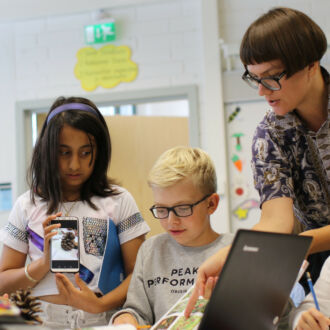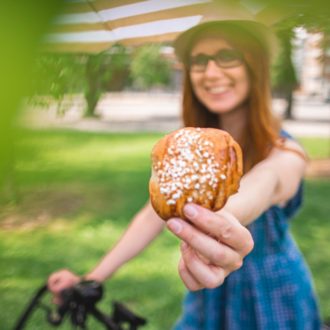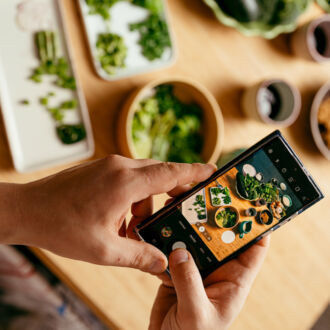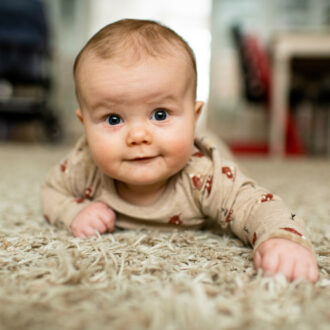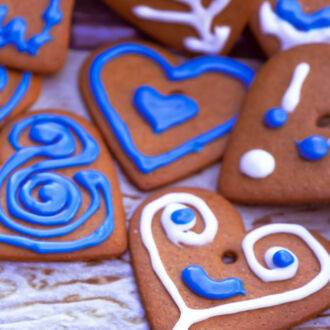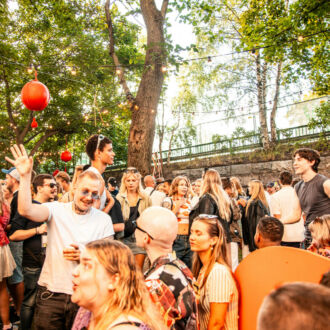The menu consists of chicken and vegetable stir-fry with noodles followed by an orange charlotte for dessert. But before they start slicing ginger, garlic and peppers, they have to attend to a few other things.
This Monday morning begins with a quiz about vitamins on a game-based online learning platform. Then there’s a review of the homework assignment: cleaning a pair of shoes, rearranging a wardrobe at home and preparing a healthy meal.
On another online platform, everyone has submitted photos and descriptions of how they fulfilled the assignment.
Before getting to the highlight of today’s lesson, the cooking, the children watch a video about protein, learning why it’s important to the body and what kinds of foods provide it.
Integrated into the national curriculum
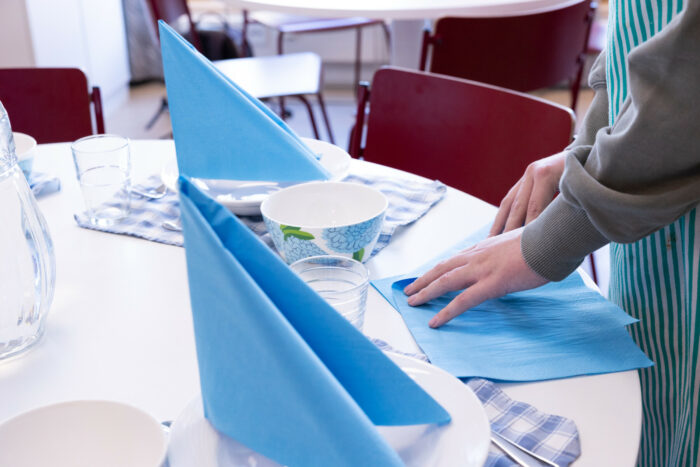
Fine dining: Setting the table is part of the fun.
Photo: Catarina Stewen
Home economics is part of the Finnish national core curriculum for all seventh-graders, most of whom are 13 years old. It’s also available as an elective for eighth- and ninth-graders.
The aim is to teach every teenage pupil in Finland basic skills in cooking, washing, cleaning, health, nutrition, hygiene, consumer rights, economics and sustainability.
“Every lesson consists of a theoretical part and a practical part,” says Eva Green, a teacher at Strömborgska School in Porvoo, a town about 50 kilometres (30 miles) east of Helsinki. “For instance, pupils learn about using local food ingredients that are in season, about recycling and about using leftovers in meals.”
Although teachers plan their own lessons and approaches, the national core curriculum provides a uniform foundation and framework, ensuring that education is equal throughout Finland.
Teamwork
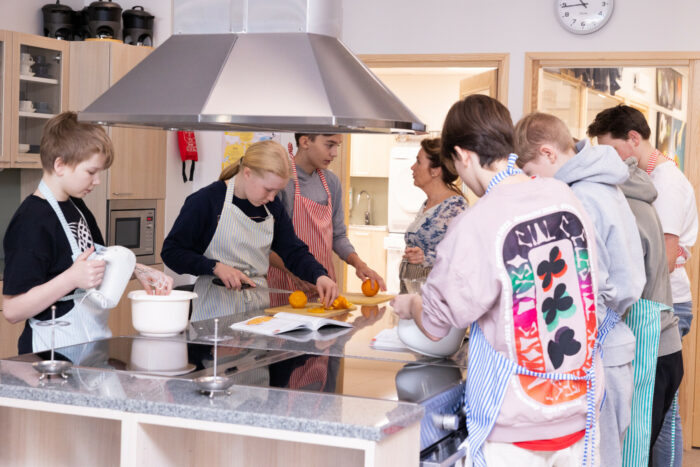
The pupils prepare the food in small groups.
Photo: Catarina Stewen
Once Green has presented the day’s recipes and cooking methods, the students begin working in small groups. First they prepare the dessert, which needs to be refrigerated for a while before serving.
Alexander cuts oranges into thin slices while Liam soaks the gelatin. Nicholas and Jens whip the cream and mix the other ingredients. The team works efficiently, and in no time, the orange charlotte is ready for the fridge. Then the boys wash the dishes and clean up.
“We learn the basics of cooking and how to clean, wash dishes, lay the table and eat healthily,” says Alexander. “The class prepares us for an independent life, so that when we move away from home someday, we’ll know how to manage.”
The special classroom contains four fully equipped kitchens.
Each one has two electric stoves, two ovens, a sink, a dishwasher, kitchen utensils, and granite-covered work surfaces that are hygienic and easy to maintain. There are also cupboards full of plates and glasses, and there are even a washer and a dryer for clothes.
The garbage bins make it easy to pre-sort the waste, with six separate containers: plastic, metal, paper and cardboard recyclables; compost; and other garbage.
Hands-on lessons and digital content
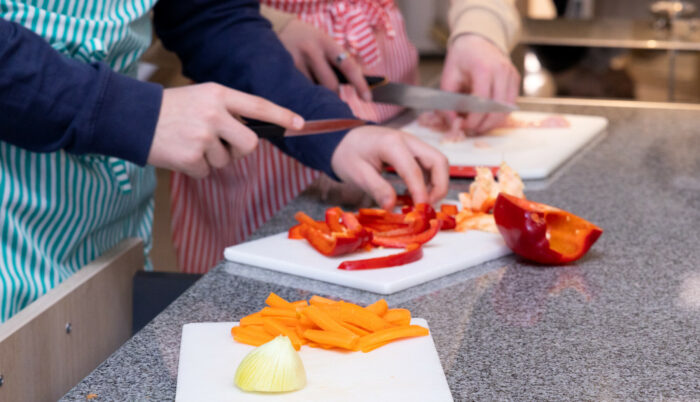
The main course: Chopping chicken and vegetables for the stir-fry.
Photo: Catarina Stewen
Stella, Jonathan and Jeremias point out that the hands-on lessons are a welcome contrast to other classes that are more theoretical.
“Apart from the cooking, textile care seemed useful,” says Stella. “We learned to interpret the washing instructions on clothes and used the washing machine in the classroom.”
While the classwork is mostly practical and uses a physical book, the teacher relies on digital tools for revision, educational games, homework and presentations.
“We follow a digital path in the local curriculum, preparing pupils for a digital future,” Green says.
Every week for a year

Today’s lesson began with a quiz about vitamins on a game-based online learning platform.
Photo: Catarina Stewen
After a break, it’s time to cook the main course.
“Do you remember what was special about handling raw chicken?” Green asks the class.
“Separate cutting board, wash hands before and after, clean utensils directly,” says Emil.
The teams get going, cutting chicken, vegetables, ginger and garlic and boiling noodles while chatting at the same time. One from each group sets the table, including colourful napkins. The atmosphere is warm and calm, with Green circulating to give instructions where needed.
“They are all getting independent after having a weekly class for almost one year,” she says. “When the autumn term began, I needed to offer more guidance in the basics, but now they know what to do.”
Best part of the lesson
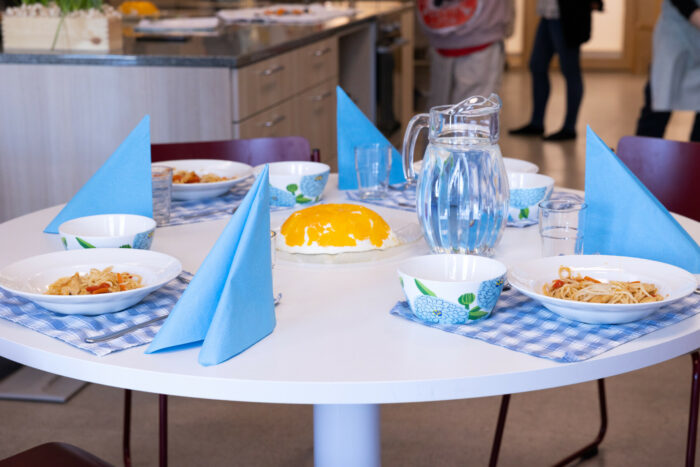
Dinner is served: Part of learning how to cook is sitting down to enjoy a meal with your friends.
Photo: Catarina Stewen
The chicken noodle stir-fry is ready, and the dessert looks delicious, too. The pupils sit down together to enjoy their meal.
“This is the best part,” says Emil. “Eating what we have prepared.”
Before class is dismissed, the teenagers clean the kitchen, fill the dishwashers and ensure that everything is spotless and ready for the next group.
Dessert recipes from a home economics class in Finland
Orange charlotte
Orange charlotte is a fresh twist on the classic dessert charlotte russe. It’s a popular dish that forms part of the home economics curriculum at numerous schools across Finland.
- 2 oranges
- 3 sheets of gelatin
- 2 dl whipping cream
- 200–250 g quark (a dairy product with a creamy consistency; some have compared it to French fromage blanc)
- 3/4 dl sugar
- 1 teaspoon vanilla sugar
- grated orange peel from one of the oranges
Begin by washing the oranges. Grate the orange part of the peel from one of the oranges. Then peel both oranges and cut them into thin slices. In a bowl that can hold at least one litre, line the edges with orange slices. Cut the leftover slices into pieces – we’ll use them later.
Soak the gelatin sheets for at least five minutes in cold water.
Whip the cream until slightly fluffy. Add the quark, sugar, vanilla sugar, grated orange peel and remaining pieces of orange.
Remove the gelatin sheets without squeezing the excess water out of them, and put them in a pot on the stove. Warm them up until they dissolve, but be sure not to boil them. Add to the quark mixture and stir, but be careful not to stir too hard or clumps will form.
Pour the mixture into the bowl lined with orange slices. Cover the bowl and refrigerate for a couple hours until the dessert sets. Turn the bowl upside down on a serving plate, then remove the bowl, leaving the dessert ready to serve.
Autumn roll cake
Cake base:
- 2 eggs
- 1 dl sugar
- 1/2 dl rye flour
- 1/2 dl potato flour
- 1/2 teaspoon baking powder
Preheat oven to 225 degrees Celsius. Whip the eggs and sugar until white and fluffy.
Mix the baking powder, rye flour and potato flour. Gradually blend the dry ingredients into the egg mixture (it’s good to use a sifter). Pour the batter onto a piece of baking paper on an oven tray with raised edges. Bake for about five minutes.
Sprinkle sugar over a new piece of baking paper. Place the finished cake base upside down onto the sugar-coated paper and peel the other paper away from the cake. Let the cake base cool under a clean tea towel.
Filling:
- 1 dl whipping cream
- 1/4–1/2 dl sugar
- 1/2 teaspoon vanilla sugar
- 1 dl quark (a dairy product with a creamy consistency; some have compared it to French fromage blanc)
- 1 dl lingonberries or other berries
- 1/2–1 banana
Whip the cream and the sugar together until foamy. Separately, mash the banana or cut it into small pieces. Mix the quark, the berries and the banana into the cream and sugar. You can taste the mixture and add a bit more sugar if desired.
Spread the filling over the cooled cake base. Roll it up into a long cylinder. Let the cake stand in a cool place until you serve it.
By Catarina Stewen, May 2023
Recipes courtesy of Eva Green
